Artificial Intelligence (AI) Market Size 2025-2029
The artificial intelligence (AI) market size is valued to increase by USD 369.1 billion, at a CAGR of 34.7% from 2024 to 2029. Prevention of fraud and malicious attacks will drive the artificial intelligence (ai) market.
Major Market Trends & Insights
- North America dominated the market and accounted for a 55% growth during the forecast period.
- By Component - Software segment was valued at USD 27.50 billion in 2023
- By End-user - Retail segment accounted for the largest market revenue share in 2023
Market Size & Forecast
- Market Opportunities: USD 975.62 billion
- Market Future Opportunities: USD 369.10 billion
- CAGR from 2024 to 2029 : 34.7%
Market Summary
- The market is a dynamic and ever-evolving landscape, characterized by continuous advancements in core technologies and applications. Key technologies driving this growth include machine learning, natural language processing, and robotics, while applications span industries such as healthcare, finance, and manufacturing. The market is also witnessing a significant shift towards cloud-based AI services, with major players like Microsoft, Google, and Amazon leading the charge. However, challenges persist, including the need to prevent fraud and malicious attacks, the shortage of AI experts, and increasing regulatory scrutiny.
- According to recent reports, the global AI market is expected to reach a 25% adoption rate by 2025, underscoring its transformative potential across various sectors. This data-driven narrative reflects the ongoing unfolding of market activities and evolving patterns, providing valuable insights for businesses looking to leverage AI for competitive advantage.
What will be the Size of the Artificial Intelligence (AI) Market during the forecast period?
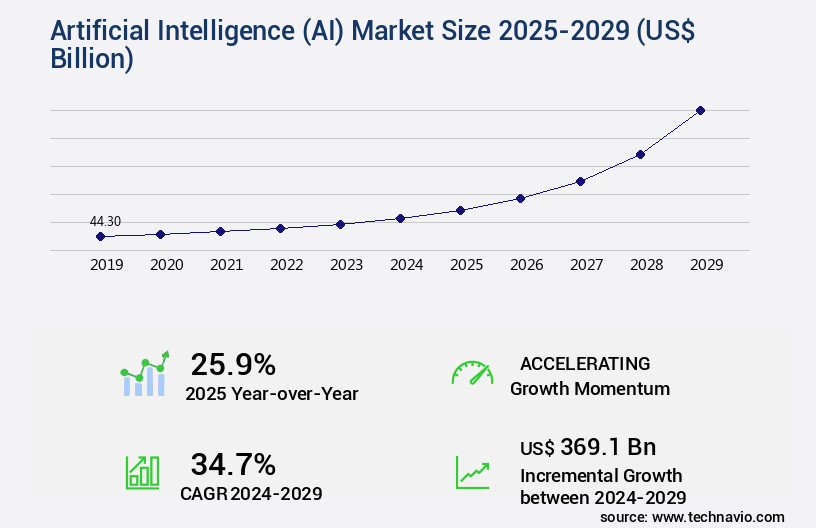
Get Key Insights on Market Forecast (PDF) Request Free Sample
How is the Artificial Intelligence (AI) Market Segmented ?
The artificial intelligence (AI) industry research report provides comprehensive data (region-wise segment analysis), with forecasts and estimates in "USD billion" for the period 2025-2029, as well as historical data from 2019-2023 for the following segments.
- Component
- Software
- Hardware
- Services
- End-user
- Retail
- Banking
- Manufacturing
- Healthcare
- Others
- Technology
- Deep learning
- Machine learning
- NLP
- Gen AI
- Geography
- North America
- Europe
- APAC
- South America
- Rest of World (ROW)
By Component Insights
The software segment is estimated to witness significant growth during the forecast period.
Artificial Intelligence (AI) is revolutionizing the software development landscape as developers leverage AI tools to create intelligent applications. These tools, which include algorithms, libraries, frameworks, and developer kits, enable the integration of machine learning, speech recognition, and other advanced AI features. According to recent studies, the usage of AI in software development is becoming increasingly common, with 30% of developers reporting current implementation and 45% planning to adopt AI tools in the near future. Moreover, the future growth prospects of the AI market are promising, with 35% of businesses anticipating significant increases in AI adoption within the next three years.
AI software is poised to transform various sectors by automating manual tasks, enhancing employee experience, and providing data-driven insights. Fuzzy logic systems and genetic algorithms are integral components of AI, enabling process optimization and data mining techniques. Expert systems, speech recognition technology, sentiment analysis tools, and decision support systems facilitate improved customer relationship management. Deep learning models and risk assessment models contribute to pattern recognition systems, while neural network architecture and natural language generation advance knowledge representation. Anomaly detection systems, machine learning algorithms, and robotic process automation are essential for cognitive computing and AI-powered automation. Fraud detection algorithms, computer vision systems, and reinforcement learning are crucial for industries like finance, healthcare, and manufacturing.
Furthermore, reasoning mechanisms, natural language processing, predictive modeling, image processing techniques, and chatbot development are vital for creating intelligent applications across various sectors. The continuous evolution of AI technology and its applications underscores the importance of staying informed and adopting these tools to remain competitive in today's business landscape.
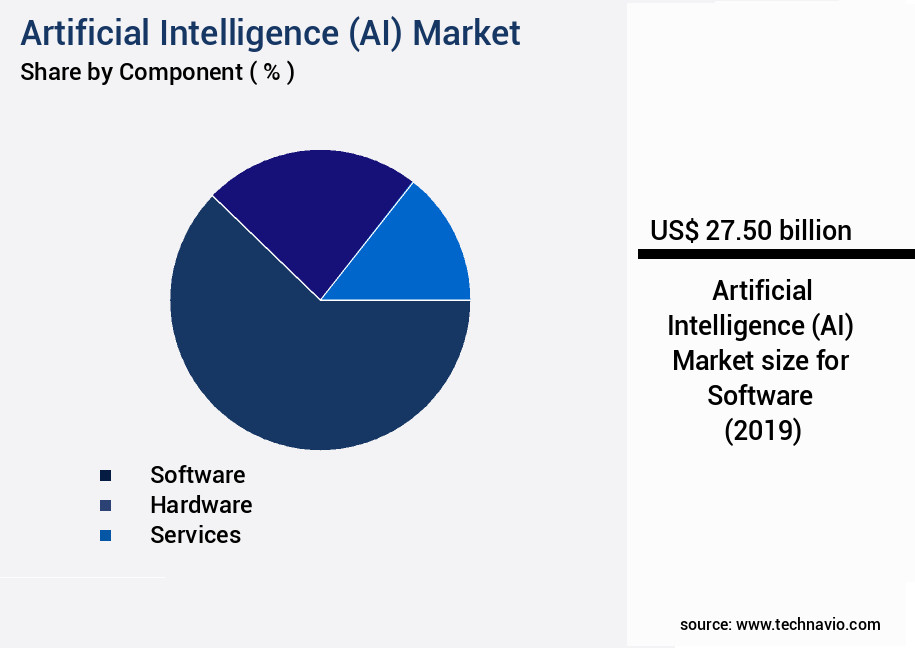
Request Free Sample
The Software segment was valued at USD 27.50 billion in 2019 and showed a gradual increase during the forecast period.
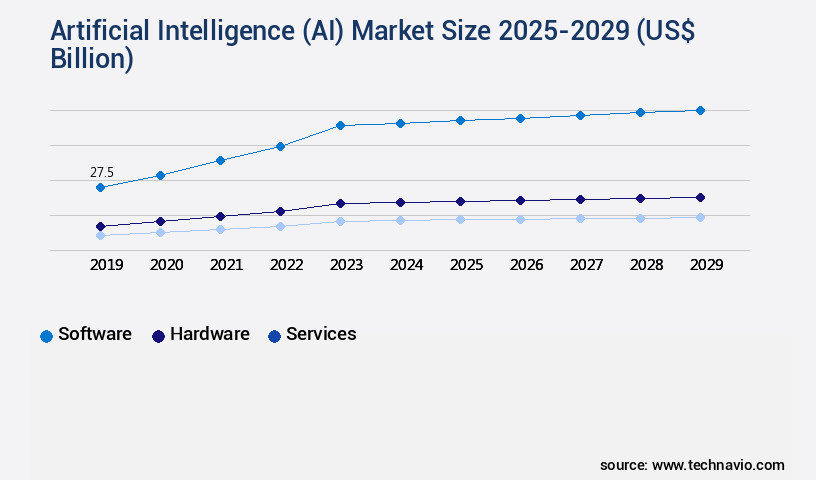
Request Free Sample
Regional Analysis
North America is estimated to contribute 55% to the growth of the global market during the forecast period.Technavio's analysts have elaborately explained the regional trends and drivers that shape the market during the forecast period.
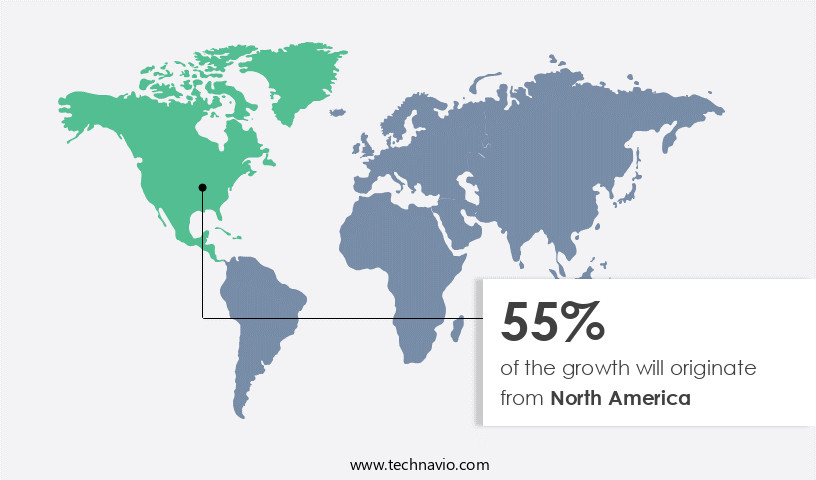
See How Artificial Intelligence (AI) Market Demand is Rising in North America Request Free Sample
The North American region, spearheaded by the US, is poised to dominate AI spending. As the business world gains a clearer understanding of AI's potential, investment patterns shift. Frequency decreases, while investment sizes increase following industry competition. Notable sectors like healthcare, education, and autonomous driving continue to attract significant AI investment. Leading technology companies, including Google LLC, IBM, Microsoft, and Amazon Web Services, Inc., are primarily based in the US and contribute substantially to this market.
Market Dynamics
Our researchers analyzed the data with 2024 as the base year, along with the key drivers, trends, and challenges. A holistic analysis of drivers will help companies refine their marketing strategies to gain a competitive advantage.
The market is experiencing robust growth, driven by the integration of advanced technologies such as deep learning for image recognition, natural language processing applications, and machine learning in finance. AI-powered customer service chatbots, predictive modeling for fraud detection, and reinforcement learning for robotics are transforming industries, enhancing operational efficiency and customer experience. Computer vision for medical diagnosis and AI for supply chain optimization are gaining significant traction, with adoption rates in these sectors nearly double those in traditional industries. Natural language generation for content creation, machine learning for risk management, and AI-driven personalized recommendations are revolutionizing business intelligence, while AI ethics and responsible AI development gain increasing importance.
More than 70% of new product developments focus on improving operational efficiency and optimizing processes through machine learning for healthcare, implementation of AI in manufacturing, and machine learning for process automation. Big data analytics for business intelligence is a significant growth area, with the industrial application segment accounting for a significantly larger share than the academic segment. The AI market landscape is competitive, with a minority of players, less than 15%, dominating the high-end instrument market. These leading companies are investing in developing AI-powered decision support systems and applying machine learning to healthcare, robotics, and cybersecurity threat detection.
Using deep learning for anomaly detection and implementing AI for improving cybersecurity are emerging trends, as businesses seek to enhance their security posture and mitigate risks.
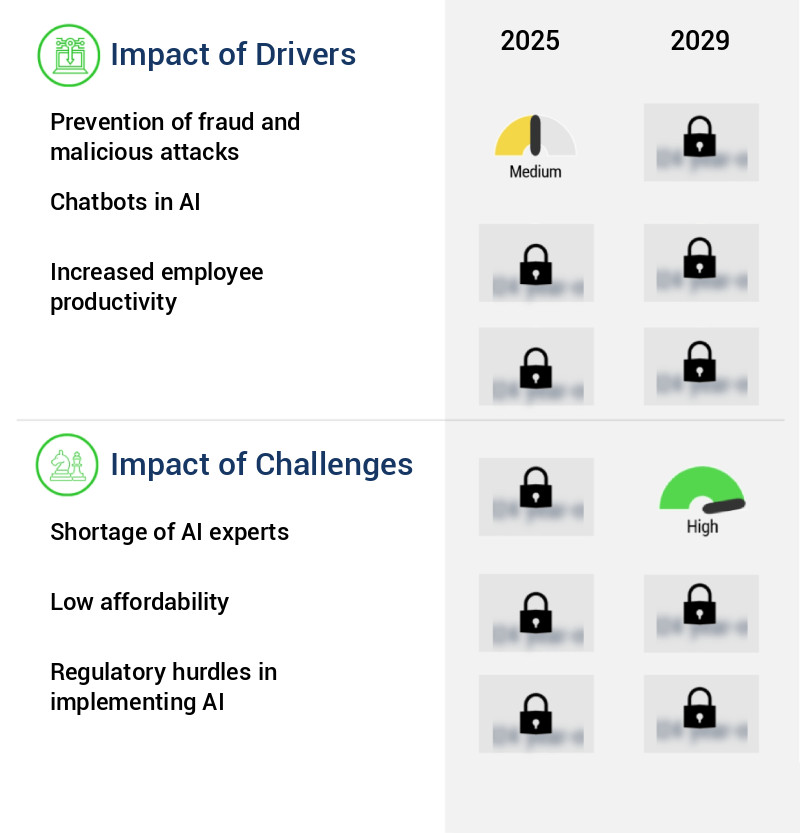
What are the key market drivers leading to the rise in the adoption of Artificial Intelligence (AI) Industry?
- Preventing fraud and malicious attacks is a crucial factor driving market growth, as organizations prioritize safeguarding their assets and maintaining the integrity of their systems.
- The cybersecurity landscape has witnessed a significant increase in the frequency and sophistication of fraudulent activities and malicious attacks, posing a serious threat to both personal data and organizational information. In response, businesses are turning to Artificial Intelligence (AI) technologies to bolster their defenses. AI solutions enable threat detection, pattern recognition, and expedited response times, making them an essential tool against evolving cyber threats. Moreover, organizations are capitalizing on the collection and analysis of user behavior and key trends to inform product enhancements and drive business growth.
- However, this data-driven approach also introduces new vulnerabilities, as cybercriminals seek to bypass security mechanisms and gain unauthorized access to sensitive information. The continuous evolution of cyber threats necessitates a dynamic, data-driven approach to cybersecurity, ensuring that businesses remain one step ahead of potential threats.
What are the market trends shaping the Artificial Intelligence (AI) Industry?
- The trend in the market involves an increase in the usage of cloud-based Artificial Intelligence services. (Or) Cloud-based Artificial Intelligence services are experiencing significant growth in market trends.
- AI technology's impact on businesses is profound, leading to its adoption across various sectors and use cases. Applications range from recommendation engines and pricing optimization to lead generation, chatbots, and supply chain optimization. Integrating AI in on-premises data centers necessitates substantial computer and data storage capabilities for faster processing. Developing in-house AI products can be costly, prompting many companies to consider alternative solutions. The market for AI technologies continues to evolve, with advancements in machine learning and deep learning driving innovation. Companies must stay informed of these developments to remain competitive. For instance, machine learning algorithms can analyze vast amounts of data to identify patterns and trends, while deep learning models can recognize complex patterns and make decisions based on context.
- These capabilities offer significant benefits, such as improved operational efficiency, enhanced customer experiences, and increased revenue opportunities. Despite the challenges, the adoption of AI technologies is on the rise, with businesses recognizing their potential to drive growth and innovation.
What challenges does the Artificial Intelligence (AI) Industry face during its growth?
- The shortage of AI experts poses a significant challenge to the industry's growth trajectory, as the demand for advanced technological solutions continues to escalate.
- The integration of Artificial Intelligence (AI) and Machine Learning (ML) in businesses presents significant opportunities but also challenges for organizations, particularly those without extensive resources. Access to substantial data sets, specialized infrastructure, and processing power are essential for effective AI implementation. Moreover, the scarcity of skilled AI experts adds to the challenge, as top technology companies compete for their services. Companies must carefully consider the use cases for AI/ML algorithms before scaling their adoption.
- These requirements necessitate substantial investments, making AI an elusive prospect for many organizations. Despite these hurdles, the benefits of AI, such as improved operational efficiency and enhanced customer experiences, make it a worthwhile pursuit for businesses across sectors.
Exclusive Technavio Analysis on Customer Landscape
The artificial intelligence (ai) market forecasting report includes the adoption lifecycle of the market, covering from the innovator's stage to the laggard's stage. It focuses on adoption rates in different regions based on penetration. Furthermore, the artificial intelligence (ai) market report also includes key purchase criteria and drivers of price sensitivity to help companies evaluate and develop their market growth analysis strategies.
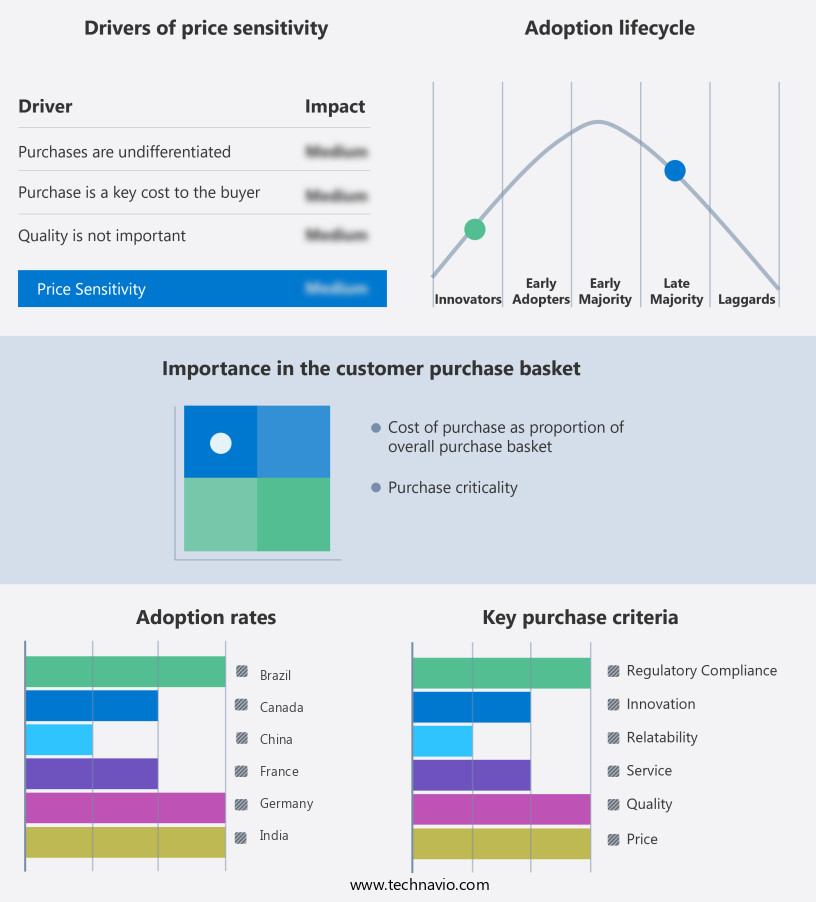
Customer Landscape of Artificial Intelligence (AI) Industry
Competitive Landscape
Companies are implementing various strategies, such as strategic alliances, artificial intelligence (ai) market forecast, partnerships, mergers and acquisitions, geographical expansion, and product/service launches, to enhance their presence in the industry.
Advanced Micro Devices Inc. - The company specializes in delivering advanced AI solutions, enabling organizations to optimize operations, enhance productivity, and stay competitive. Their offerings cater to various industries, ensuring versatile applications and customizable integrations.
The industry research and growth report includes detailed analyses of the competitive landscape of the market and information about key companies, including:
- Advanced Micro Devices Inc.
- Alphabet Inc.
- Amazon.com Inc.
- Apple Inc.
- Argo AI LLC
- Baidu Inc.
- China Cambrian Technology Co. Ltd.
- CognitiveScale
- DataDirect Networks Inc.
- Graphcore Ltd.
- Huawei Technologies Co. Ltd.
- Intel Corp.
- International Business Machines Corp.
- Microsoft Corp.
- Nuance Communications Inc.
- NVIDIA Corp.
- Oracle Corp.
- Qualcomm Inc.
- Tesla Inc.
- Wipro Ltd.
Qualitative and quantitative analysis of companies has been conducted to help clients understand the wider business environment as well as the strengths and weaknesses of key industry players. Data is qualitatively analyzed to categorize companies as pure play, category-focused, industry-focused, and diversified; it is quantitatively analyzed to categorize companies as dominant, leading, strong, tentative, and weak.
Recent Development and News in Artificial Intelligence (AI) Market
- In January 2024, IBM announced the launch of its new AI-powered financial advisor, Watson Finance, designed to provide personalized investment recommendations to clients. The solution uses machine learning algorithms to analyze market trends, news, and client data, aiming to deliver more accurate and efficient investment advice (IBM Press Release, 2024).
- In March 2024, Microsoft and OpenAI, an artificial intelligence research laboratory, joined forces to develop large-scale AI models. Their collaboration aimed to advance AI technology and create new applications, including the integration of OpenAI's ChatGPT model into Microsoft's products and services (Microsoft News Center, 2024).
- In May 2024, Google's DeepMind AI division secured a strategic partnership with the UK's National Health Service (NHS) to develop AI solutions for diagnosing and treating various health conditions. The collaboration could potentially revolutionize healthcare by improving diagnosis accuracy and efficiency (Google Blog, 2024).
- In April 2025, Amazon Web Services (AWS) announced a significant investment of USD1 billion in its AI and machine learning division. The investment aimed to accelerate the development of new AI services and expand its existing offerings, further strengthening AWS's position in the AI market (AWS Press Release, 2025).
Dive into Technavio's robust research methodology, blending expert interviews, extensive data synthesis, and validated models for unparalleled Artificial Intelligence (AI) Market insights. See full methodology.
|
Market Scope
|
|
Report Coverage
|
Details
|
|
Page number
|
240
|
|
Base year
|
2024
|
|
Historic period
|
2019-2023 |
|
Forecast period
|
2025-2029
|
|
Growth momentum & CAGR
|
Accelerate at a CAGR of 34.7%
|
|
Market growth 2025-2029
|
USD 369.1 billion
|
|
Market structure
|
Fragmented
|
|
YoY growth 2024-2025(%)
|
25.9
|
|
Key countries
|
US, Canada, China, Germany, Brazil, UK, France, India, Japan, and Italy
|
|
Competitive landscape
|
Leading Companies, Market Positioning of Companies, Competitive Strategies, and Industry Risks
|
Request Free Sample
Research Analyst Overview
- Artificial Intelligence (AI) is a dynamic and evolving market, characterized by the continuous adoption and refinement of advanced technologies. Fuzzy logic systems and genetic algorithms have long been essential components of AI, providing robust process optimization solutions. Data visualization dashboards, CRM systems, and data mining techniques facilitate insights from vast datasets, while expert systems and speech recognition technology enhance decision-making capabilities. Sentiment analysis tools and decision support systems enable businesses to understand customer behavior and preferences, driving improved customer engagement. Supply chain management and big data analytics optimize operations, reducing costs and increasing efficiency. Deep learning models and risk assessment models offer enhanced predictive capabilities, allowing for proactive risk management and informed decision-making.
- Pattern recognition systems, knowledge representation, and neural network architecture form the foundation of advanced AI applications, such as natural language generation and anomaly detection systems. Machine learning algorithms, robotic process automation, cognitive computing, and AI-powered automation are transforming industries, from manufacturing to finance. Fraud detection algorithms, computer vision systems, and reinforcement learning are key innovations in the realm of security and automation. Reasoning mechanisms, natural language processing, predictive modeling, image processing techniques, chatbot development, and predictive maintenance further expand the scope of AI applications. These technologies are not static; they continue to evolve and interconnect, creating a complex and intricate web of AI capabilities.
- As businesses navigate this landscape, they can leverage AI to optimize processes, enhance decision-making, and gain a competitive edge.
What are the Key Data Covered in this Artificial Intelligence (AI) Market Research and Growth Report?
-
What is the expected growth of the Artificial Intelligence (AI) Market between 2025 and 2029?
-
What segmentation does the market report cover?
-
The report is segmented by Component (Software, Hardware, and Services), End-user (Retail, Banking, Manufacturing, Healthcare, and Others), Technology (Deep learning, Machine learning, NLP, and Gen AI), and Geography (North America, Europe, APAC, South America, and Middle East and Africa)
-
Which regions are analyzed in the report?
-
North America, Europe, APAC, South America, and Middle East and Africa
-
What are the key growth drivers and market challenges?
-
Who are the major players in the Artificial Intelligence (AI) Market?
-
Advanced Micro Devices Inc., Alphabet Inc., Amazon.com Inc., Apple Inc., Argo AI LLC, Baidu Inc., China Cambrian Technology Co. Ltd., CognitiveScale, DataDirect Networks Inc., Graphcore Ltd., Huawei Technologies Co. Ltd., Intel Corp., International Business Machines Corp., Microsoft Corp., Nuance Communications Inc., NVIDIA Corp., Oracle Corp., Qualcomm Inc., Tesla Inc., and Wipro Ltd.
Market Research Insights
- The market continues to expand, with global spending projected to reach USD613.3 billion by 2024, a significant increase from the USD35.8 billion invested in 2019. This growth is driven by the integration of AI in various industries, including healthcare, finance, and manufacturing, to enhance efficiency, productivity, and decision-making. However, the market's evolution also presents challenges. Ethical considerations, such as data privacy concerns and network security, become increasingly important as AI systems process vast amounts of sensitive information. Algorithm selection, model monitoring, and cybersecurity threats require constant attention to ensure responsible AI implementation. Hyperparameter tuning, regularization techniques, and ensemble methods are essential for overcoming challenges like overfitting and underfitting in model training.
- Moreover, AI safety, dimensionality reduction, and AI governance are crucial aspects of the market's development. Time series analysis, feature engineering, and explainable AI contribute to improved model deployment and evaluation, while classification and regression algorithms undergo continuous refinement. The balance between bias-variance tradeoff and unsupervised learning remains a key focus for researchers and practitioners alike. Ultimately, the AI market's future lies in the hands of those who can navigate its complexities and ensure its responsible and secure application.
We can help! Our analysts can customize this artificial intelligence (AI) market research report to meet your requirements.
Get in touch
1 Executive Summary
- 1.1 Market overview
- Executive Summary - Chart on Market Overview
- Executive Summary - Data Table on Market Overview
- Executive Summary - Chart on Global Market Characteristics
- Executive Summary - Chart on Market by Geography
- Executive Summary - Chart on Market Segmentation by Component
- Executive Summary - Chart on Market Segmentation by End-user
- Executive Summary - Chart on Market Segmentation by Technology
- Executive Summary - Chart on Incremental Growth
- Executive Summary - Data Table on Incremental Growth
- Executive Summary - Chart on Company Market Positioning
2 Technavio Analysis
- 2.1 Analysis of price sensitivity, lifecycle, customer purchase basket, adoption rates, and purchase criteria
- Analysis of price sensitivity, lifecycle, customer purchase basket, adoption rates, and purchase criteria
- 2.2 Criticality of inputs and Factors of differentiation
- Overview on criticality of inputs and factors of differentiation
- 2.3 Factors of disruption
- Overview on factors of disruption
- 2.4 Impact of drivers and challenges
- Impact of drivers and challenges in 2024 and 2029
3 Market Landscape
- 3.1 Market ecosystem
- Parent Market
- Data Table on - Parent Market
- 3.2 Market characteristics
- Market characteristics analysis
4 Market Sizing
- 4.1 Market definition
- Offerings of companies included in the market definition
- 4.2 Market segment analysis
- 4.4 Market outlook: Forecast for 2024-2029
- Chart on Global - Market size and forecast 2024-2029 ($ billion)
- Data Table on Global - Market size and forecast 2024-2029 ($ billion)
- Chart on Global Market: Year-over-year growth 2024-2029 (%)
- Data Table on Global Market: Year-over-year growth 2024-2029 (%)
5 Historic Market Size
- 5.1 Global Artificial Intelligence (AI) Market 2019 - 2023
- Historic Market Size - Data Table on Global Artificial Intelligence (AI) Market 2019 - 2023 ($ billion)
- 5.2 Component segment analysis 2019 - 2023
- Historic Market Size - Component Segment 2019 - 2023 ($ billion)
- 5.3 End-user segment analysis 2019 - 2023
- Historic Market Size - End-user Segment 2019 - 2023 ($ billion)
- 5.4 Technology segment analysis 2019 - 2023
- Historic Market Size - Technology Segment 2019 - 2023 ($ billion)
- 5.5 Geography segment analysis 2019 - 2023
- Historic Market Size - Geography Segment 2019 - 2023 ($ billion)
- 5.6 Country segment analysis 2019 - 2023
- Historic Market Size - Country Segment 2019 - 2023 ($ billion)
6 Qualitative Analysis
- 6.1 The impact of AI in the global artificial intelligence (AI) market
7 Five Forces Analysis
- 7.1 Five forces summary
- Five forces analysis - Comparison between 2024 and 2029
- 7.2 Bargaining power of buyers
- Bargaining power of buyers - Impact of key factors 2024 and 2029
- 7.3 Bargaining power of suppliers
- Bargaining power of suppliers - Impact of key factors in 2024 and 2029
- 7.4 Threat of new entrants
- Threat of new entrants - Impact of key factors in 2024 and 2029
- 7.5 Threat of substitutes
- Threat of substitutes - Impact of key factors in 2024 and 2029
- 7.6 Threat of rivalry
- Threat of rivalry - Impact of key factors in 2024 and 2029
- 7.7 Market condition
- Chart on Market condition - Five forces 2024 and 2029
8 Market Segmentation by Component
- 8.1 Market segments
- Chart on Component - Market share 2024-2029 (%)
- Data Table on Component - Market share 2024-2029 (%)
- 8.2 Comparison by Component
- Chart on Comparison by Component
- Data Table on Comparison by Component
- 8.3 Software - Market size and forecast 2024-2029
- Chart on Software - Market size and forecast 2024-2029 ($ billion)
- Data Table on Software - Market size and forecast 2024-2029 ($ billion)
- Chart on Software - Year-over-year growth 2024-2029 (%)
- Data Table on Software - Year-over-year growth 2024-2029 (%)
- 8.4 Hardware - Market size and forecast 2024-2029
- Chart on Hardware - Market size and forecast 2024-2029 ($ billion)
- Data Table on Hardware - Market size and forecast 2024-2029 ($ billion)
- Chart on Hardware - Year-over-year growth 2024-2029 (%)
- Data Table on Hardware - Year-over-year growth 2024-2029 (%)
- 8.5 Services - Market size and forecast 2024-2029
- Chart on Services - Market size and forecast 2024-2029 ($ billion)
- Data Table on Services - Market size and forecast 2024-2029 ($ billion)
- Chart on Services - Year-over-year growth 2024-2029 (%)
- Data Table on Services - Year-over-year growth 2024-2029 (%)
- 8.6 Market opportunity by Component
- Market opportunity by Component ($ billion)
- Data Table on Market opportunity by Component ($ billion)
9 Market Segmentation by End-user
- 9.1 Market segments
- Chart on End-user - Market share 2024-2029 (%)
- Data Table on End-user - Market share 2024-2029 (%)
- 9.2 Comparison by End-user
- Chart on Comparison by End-user
- Data Table on Comparison by End-user
- 9.3 Retail - Market size and forecast 2024-2029
- Chart on Retail - Market size and forecast 2024-2029 ($ billion)
- Data Table on Retail - Market size and forecast 2024-2029 ($ billion)
- Chart on Retail - Year-over-year growth 2024-2029 (%)
- Data Table on Retail - Year-over-year growth 2024-2029 (%)
- 9.4 Banking - Market size and forecast 2024-2029
- Chart on Banking - Market size and forecast 2024-2029 ($ billion)
- Data Table on Banking - Market size and forecast 2024-2029 ($ billion)
- Chart on Banking - Year-over-year growth 2024-2029 (%)
- Data Table on Banking - Year-over-year growth 2024-2029 (%)
- 9.5 Manufacturing - Market size and forecast 2024-2029
- Chart on Manufacturing - Market size and forecast 2024-2029 ($ billion)
- Data Table on Manufacturing - Market size and forecast 2024-2029 ($ billion)
- Chart on Manufacturing - Year-over-year growth 2024-2029 (%)
- Data Table on Manufacturing - Year-over-year growth 2024-2029 (%)
- 9.6 Healthcare - Market size and forecast 2024-2029
- Chart on Healthcare - Market size and forecast 2024-2029 ($ billion)
- Data Table on Healthcare - Market size and forecast 2024-2029 ($ billion)
- Chart on Healthcare - Year-over-year growth 2024-2029 (%)
- Data Table on Healthcare - Year-over-year growth 2024-2029 (%)
- 9.7 Others - Market size and forecast 2024-2029
- Chart on Others - Market size and forecast 2024-2029 ($ billion)
- Data Table on Others - Market size and forecast 2024-2029 ($ billion)
- Chart on Others - Year-over-year growth 2024-2029 (%)
- Data Table on Others - Year-over-year growth 2024-2029 (%)
- 9.8 Market opportunity by End-user
- Market opportunity by End-user ($ billion)
- Data Table on Market opportunity by End-user ($ billion)
10 Market Segmentation by Technology
- 10.1 Market segments
- Chart on Technology - Market share 2024-2029 (%)
- Data Table on Technology - Market share 2024-2029 (%)
- 10.2 Comparison by Technology
- Chart on Comparison by Technology
- Data Table on Comparison by Technology
- 10.3 Deep learning - Market size and forecast 2024-2029
- Chart on Deep learning - Market size and forecast 2024-2029 ($ billion)
- Data Table on Deep learning - Market size and forecast 2024-2029 ($ billion)
- Chart on Deep learning - Year-over-year growth 2024-2029 (%)
- Data Table on Deep learning - Year-over-year growth 2024-2029 (%)
- 10.4 Machine learning - Market size and forecast 2024-2029
- Chart on Machine learning - Market size and forecast 2024-2029 ($ billion)
- Data Table on Machine learning - Market size and forecast 2024-2029 ($ billion)
- Chart on Machine learning - Year-over-year growth 2024-2029 (%)
- Data Table on Machine learning - Year-over-year growth 2024-2029 (%)
- 10.5 NLP - Market size and forecast 2024-2029
- Chart on NLP - Market size and forecast 2024-2029 ($ billion)
- Data Table on NLP - Market size and forecast 2024-2029 ($ billion)
- Chart on NLP - Year-over-year growth 2024-2029 (%)
- Data Table on NLP - Year-over-year growth 2024-2029 (%)
- 10.6 Gen AI - Market size and forecast 2024-2029
- Chart on Gen AI - Market size and forecast 2024-2029 ($ billion)
- Data Table on Gen AI - Market size and forecast 2024-2029 ($ billion)
- Chart on Gen AI - Year-over-year growth 2024-2029 (%)
- Data Table on Gen AI - Year-over-year growth 2024-2029 (%)
- 10.7 Market opportunity by Technology
- Market opportunity by Technology ($ billion)
- Data Table on Market opportunity by Technology ($ billion)
11 Customer Landscape
- 11.1 Customer landscape overview
- Analysis of price sensitivity, lifecycle, customer purchase basket, adoption rates, and purchase criteria
12 Geographic Landscape
- 12.1 Geographic segmentation
- Chart on Market share by geography 2024-2029 (%)
- Data Table on Market share by geography 2024-2029 (%)
- 12.2 Geographic comparison
- Chart on Geographic comparison
- Data Table on Geographic comparison
- 12.3 North America - Market size and forecast 2024-2029
- Chart on North America - Market size and forecast 2024-2029 ($ billion)
- Data Table on North America - Market size and forecast 2024-2029 ($ billion)
- Chart on North America - Year-over-year growth 2024-2029 (%)
- Data Table on North America - Year-over-year growth 2024-2029 (%)
- 12.4 Europe - Market size and forecast 2024-2029
- Chart on Europe - Market size and forecast 2024-2029 ($ billion)
- Data Table on Europe - Market size and forecast 2024-2029 ($ billion)
- Chart on Europe - Year-over-year growth 2024-2029 (%)
- Data Table on Europe - Year-over-year growth 2024-2029 (%)
- 12.5 APAC - Market size and forecast 2024-2029
- Chart on APAC - Market size and forecast 2024-2029 ($ billion)
- Data Table on APAC - Market size and forecast 2024-2029 ($ billion)
- Chart on APAC - Year-over-year growth 2024-2029 (%)
- Data Table on APAC - Year-over-year growth 2024-2029 (%)
- 12.6 South America - Market size and forecast 2024-2029
- Chart on South America - Market size and forecast 2024-2029 ($ billion)
- Data Table on South America - Market size and forecast 2024-2029 ($ billion)
- Chart on South America - Year-over-year growth 2024-2029 (%)
- Data Table on South America - Year-over-year growth 2024-2029 (%)
- 12.7 Middle East and Africa - Market size and forecast 2024-2029
- Chart on Middle East and Africa - Market size and forecast 2024-2029 ($ billion)
- Data Table on Middle East and Africa - Market size and forecast 2024-2029 ($ billion)
- Chart on Middle East and Africa - Year-over-year growth 2024-2029 (%)
- Data Table on Middle East and Africa - Year-over-year growth 2024-2029 (%)
- 12.8 US - Market size and forecast 2024-2029
- Chart on US - Market size and forecast 2024-2029 ($ billion)
- Data Table on US - Market size and forecast 2024-2029 ($ billion)
- Chart on US - Year-over-year growth 2024-2029 (%)
- Data Table on US - Year-over-year growth 2024-2029 (%)
- 12.9 Canada - Market size and forecast 2024-2029
- Chart on Canada - Market size and forecast 2024-2029 ($ billion)
- Data Table on Canada - Market size and forecast 2024-2029 ($ billion)
- Chart on Canada - Year-over-year growth 2024-2029 (%)
- Data Table on Canada - Year-over-year growth 2024-2029 (%)
- 12.10 China - Market size and forecast 2024-2029
- Chart on China - Market size and forecast 2024-2029 ($ billion)
- Data Table on China - Market size and forecast 2024-2029 ($ billion)
- Chart on China - Year-over-year growth 2024-2029 (%)
- Data Table on China - Year-over-year growth 2024-2029 (%)
- 12.11 Germany - Market size and forecast 2024-2029
- Chart on Germany - Market size and forecast 2024-2029 ($ billion)
- Data Table on Germany - Market size and forecast 2024-2029 ($ billion)
- Chart on Germany - Year-over-year growth 2024-2029 (%)
- Data Table on Germany - Year-over-year growth 2024-2029 (%)
- 12.12 Brazil - Market size and forecast 2024-2029
- Chart on Brazil - Market size and forecast 2024-2029 ($ billion)
- Data Table on Brazil - Market size and forecast 2024-2029 ($ billion)
- Chart on Brazil - Year-over-year growth 2024-2029 (%)
- Data Table on Brazil - Year-over-year growth 2024-2029 (%)
- 12.13 India - Market size and forecast 2024-2029
- Chart on India - Market size and forecast 2024-2029 ($ billion)
- Data Table on India - Market size and forecast 2024-2029 ($ billion)
- Chart on India - Year-over-year growth 2024-2029 (%)
- Data Table on India - Year-over-year growth 2024-2029 (%)
- 12.14 UK - Market size and forecast 2024-2029
- Chart on UK - Market size and forecast 2024-2029 ($ billion)
- Data Table on UK - Market size and forecast 2024-2029 ($ billion)
- Chart on UK - Year-over-year growth 2024-2029 (%)
- Data Table on UK - Year-over-year growth 2024-2029 (%)
- 12.15 France - Market size and forecast 2024-2029
- Chart on France - Market size and forecast 2024-2029 ($ billion)
- Data Table on France - Market size and forecast 2024-2029 ($ billion)
- Chart on France - Year-over-year growth 2024-2029 (%)
- Data Table on France - Year-over-year growth 2024-2029 (%)
- 12.16 Japan - Market size and forecast 2024-2029
- Chart on Japan - Market size and forecast 2024-2029 ($ billion)
- Data Table on Japan - Market size and forecast 2024-2029 ($ billion)
- Chart on Japan - Year-over-year growth 2024-2029 (%)
- Data Table on Japan - Year-over-year growth 2024-2029 (%)
- 12.17 Italy - Market size and forecast 2024-2029
- Chart on Italy - Market size and forecast 2024-2029 ($ billion)
- Data Table on Italy - Market size and forecast 2024-2029 ($ billion)
- Chart on Italy - Year-over-year growth 2024-2029 (%)
- Data Table on Italy - Year-over-year growth 2024-2029 (%)
- 12.18 Market opportunity by geography
- Market opportunity by geography ($ billion)
- Data Tables on Market opportunity by geography ($ billion)
13 Drivers, Challenges, and Opportunity/Restraints
- 13.3 Impact of drivers and challenges
- Impact of drivers and challenges in 2024 and 2029
- 13.4 Market opportunities/restraints
14 Competitive Landscape
- 14.2 Competitive Landscape
- Overview on criticality of inputs and factors of differentiation
- 14.3 Landscape disruption
- Overview on factors of disruption
- 14.4 Industry risks
- Impact of key risks on business
15 Competitive Analysis
- 15.2 Company ranking index
- 15.3 Market positioning of companies
- Matrix on companies position and classification
- 15.4 Advanced Micro Devices Inc.
- Advanced Micro Devices Inc. - Overview
- Advanced Micro Devices Inc. - Business segments
- Advanced Micro Devices Inc. - Key news
- Advanced Micro Devices Inc. - Key offerings
- Advanced Micro Devices Inc. - Segment focus
- SWOT
- 15.5 Alphabet Inc.
- Alphabet Inc. - Overview
- Alphabet Inc. - Business segments
- Alphabet Inc. - Key offerings
- Alphabet Inc. - Segment focus
- SWOT
- 15.6 Amazon.com Inc.
- Amazon.com Inc. - Overview
- Amazon.com Inc. - Business segments
- Amazon.com Inc. - Key news
- Amazon.com Inc. - Key offerings
- Amazon.com Inc. - Segment focus
- SWOT
- 15.7 Apple Inc.
- Apple Inc. - Overview
- Apple Inc. - Business segments
- Apple Inc. - Key news
- Apple Inc. - Key offerings
- Apple Inc. - Segment focus
- SWOT
- 15.8 Argo AI LLC
- Argo AI LLC - Overview
- Argo AI LLC - Product / Service
- Argo AI LLC - Key offerings
- SWOT
- 15.9 Baidu Inc.
- Baidu Inc. - Overview
- Baidu Inc. - Business segments
- Baidu Inc. - Key offerings
- Baidu Inc. - Segment focus
- SWOT
- 15.10 CognitiveScale
- CognitiveScale - Overview
- CognitiveScale - Product / Service
- CognitiveScale - Key offerings
- SWOT
- 15.11 Intel Corp.
- Intel Corp. - Overview
- Intel Corp. - Business segments
- Intel Corp. - Key news
- Intel Corp. - Key offerings
- Intel Corp. - Segment focus
- SWOT
- 15.12 International Business Machines Corp.
- International Business Machines Corp. - Overview
- International Business Machines Corp. - Business segments
- International Business Machines Corp. - Key news
- International Business Machines Corp. - Key offerings
- International Business Machines Corp. - Segment focus
- SWOT
- 15.13 Microsoft Corp.
- Microsoft Corp. - Overview
- Microsoft Corp. - Business segments
- Microsoft Corp. - Key news
- Microsoft Corp. - Key offerings
- Microsoft Corp. - Segment focus
- SWOT
- 15.14 Nuance Communications Inc.
- Nuance Communications Inc. - Overview
- Nuance Communications Inc. - Product / Service
- Nuance Communications Inc. - Key offerings
- SWOT
- 15.15 NVIDIA Corp.
- NVIDIA Corp. - Overview
- NVIDIA Corp. - Business segments
- NVIDIA Corp. - Key news
- NVIDIA Corp. - Key offerings
- NVIDIA Corp. - Segment focus
- SWOT
- 15.16 Oracle Corp.
- Oracle Corp. - Overview
- Oracle Corp. - Business segments
- Oracle Corp. - Key news
- Oracle Corp. - Key offerings
- Oracle Corp. - Segment focus
- SWOT
- 15.17 Tesla Inc.
- Tesla Inc. - Overview
- Tesla Inc. - Business segments
- Tesla Inc. - Key news
- Tesla Inc. - Key offerings
- Tesla Inc. - Segment focus
- SWOT
- 15.18 Wipro Ltd.
- Wipro Ltd. - Overview
- Wipro Ltd. - Business segments
- Wipro Ltd. - Key news
- Wipro Ltd. - Key offerings
- Wipro Ltd. - Segment focus
- SWOT
16 Appendix
- 16.2 Inclusions and exclusions checklist
- Inclusions checklist
- Exclusions checklist
- 16.3 Currency conversion rates for US$
- Currency conversion rates for US$
- 16.4 Research methodology
- 16.7 Validation techniques employed for market sizing
- Validation techniques employed for market sizing
- 16.9 360 degree market analysis
- 360 degree market analysis
- 16.10 List of abbreviations







![]() Get the report (PDF) sent to your email within minutes.
Get the report (PDF) sent to your email within minutes.
Complimentary full Excel data with your report purchase.